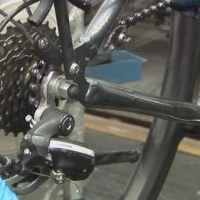2016/7/25 12:00:26

Pre ride Safety Check
Before you jump on your trusty steed and head out for a century ride, it’s a good idea to do a pre-ride bicycle safety check.
In fact it’s probably better if you do it the night before your ride, just in case you need to make some mechanical adjustments.
This doesn’t take long, and is well worth it to avoid any mishaps on the road from poorly adjusted parts.
First check the tires for correct inflation. Use a decent floor pump with a pressure gauge to ensure your tires are inflated to the desired pressure.
Tires can and do lose pressure, sometimes overnight. So make it a habit to check this before every ride.
While your there give the tires a quick check over for any glass embedded in them, and also make sure they’re in reasonable condition to last the ride.
Check and make sure the wheel quick release levers are secure, and the wheels are seated correctly.
Spin the wheels to check for any rubbing against the brake pads. Apply the brakes to ensure they’re working smoothly. When fully applied, the brake levers should stop about 20-25mms from the handlebars, if they go further then they need to be adjusted, assuming the brake pads are OK.
At the base of the cable down by the brakes is a small black cap, which you can turn clockwise to tighten the brakes, again spin the wheels to make sure you haven’t over tightened. You want a reasonable amount of play when applying the brakes, so you can slowly squeeze the levers to apply the right amount of pressure.
Give the cables a quick look over to check for any fraying.
See if the chain is well lubricated, if it looks dry or it’s been awhile since you last lubed it, then it’s worth applying some fresh lube. This will make gear changes smoother and increase the life of your drive chain, and with the back wheel off the ground, change through a few gears to make sure they do change smoothly.
Then just do a general look over for any loose parts. If you get your bike maintained regularly, which is advisable, then there shouldn’t be any problems.
If you can, take the bike for a quick spin to finally check everything is running well, and listen for any unusual noises.
If you’re running clipless pedals, check the cleats on your shoes for wear and tear.
Don’t forget to take spare tubes, tire levers, a good pump and a small mini tool with you on the ride, just in case you have problems.
That done you’re all set to sally forth on your big cycle ride, safe in the knowledge that barring unforeseen incidents, you’ll arrive back home safe and sound.
Freestyle BMX , Drive Yourself To The Limits
Freestyle BMX otherwise also known as Bike Stunt is actually the trick of maneuvering bicycles. Wel
Why a GPS Cycle Computer will improve your cycling
GPS Cycling computers are used by some of the professional cycling teams. It provides all the realt
BMX Ramp Plans For Safe, Solid Ramps
BMX bike riding is a very popular game due to the thrill and excitement it involves. However, some
Contact management E-mail : [email protected]
Copyright © 2005-2016 Outdoor sports All Rights Reserved